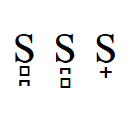Voiceless dental fricative
| Voiceless dental fricative | |||
|---|---|---|---|
| θ | |||
| IPA number | 130 | ||
| Encoding | |||
| Entity (decimal) | θ |
||
| Unicode (hex) | U+03B8 | ||
| X-SAMPA | T |
||
| Kirshenbaum | T |
||
| Braille |
|
||
|
|||
| Sound | |||
|
|
|||
| Voiceless denti-alveolar sibilant | |||
|---|---|---|---|
| s̻̪ | |||
| s̪̻ | |||
| s̟ | |||
| Encoding | |||
| X-SAMPA | s_m_d |
||
|
|||
The voiceless dental non-sibilant fricative is a type of consonantal sound used in some oral languages. It is familiar to English speakers as the 'th' in thing. Though rather rare as a phoneme in the world's inventory of languages, it is encountered in some of the most widespread and influential (see below). The symbol in the International Phonetic Alphabet that represents this sound is ⟨θ⟩, and the equivalent X-SAMPA symbol is T. The IPA symbol is the Greek letter theta, which is used for this sound in post-classical Greek, and the sound is thus often referred to as "theta".
The dental non-sibilant fricatives are often called "interdental" because they are often produced with the tongue between the upper and lower teeth, and not just against the back of the upper or lower teeth, as they are with other dental consonants.
Among the more than 60 languages with over 10 million speakers, only English, Modern Standard Arabic, Standard European Spanish, Burmese, and Greek have the voiceless dental non-sibilant fricative. Speakers of languages and dialects without the sound sometimes have difficulty producing or distinguishing it from similar sounds, especially if they have had no chance to acquire it in childhood, and typically replace it with a voiceless alveolar fricative (/s/) (as in Indonesian), voiceless dental stop (/t/), or a voiceless labiodental fricative (/f/); known respectively as th-alveolarization, th-stopping, and th-fronting.
...
Wikipedia


